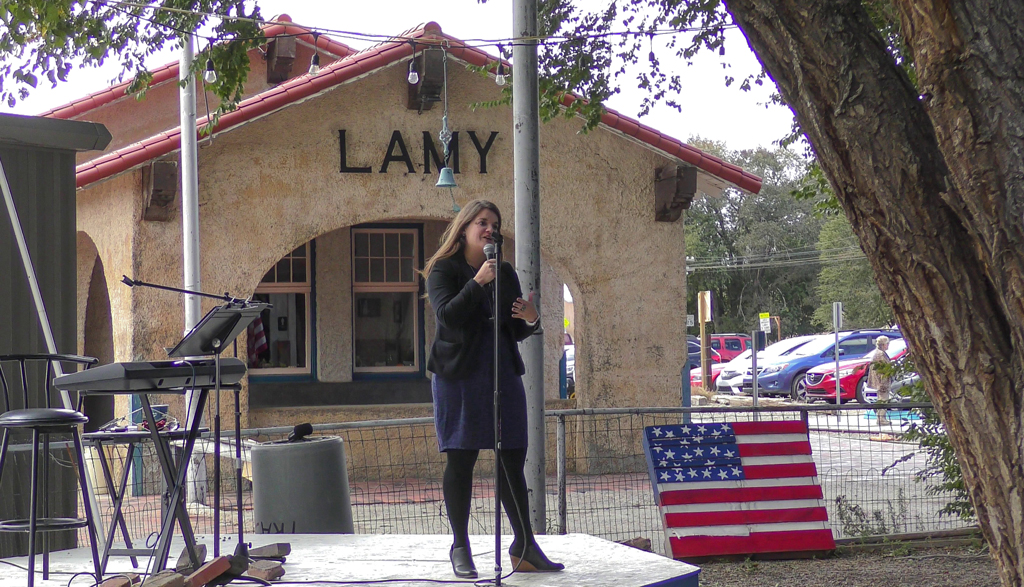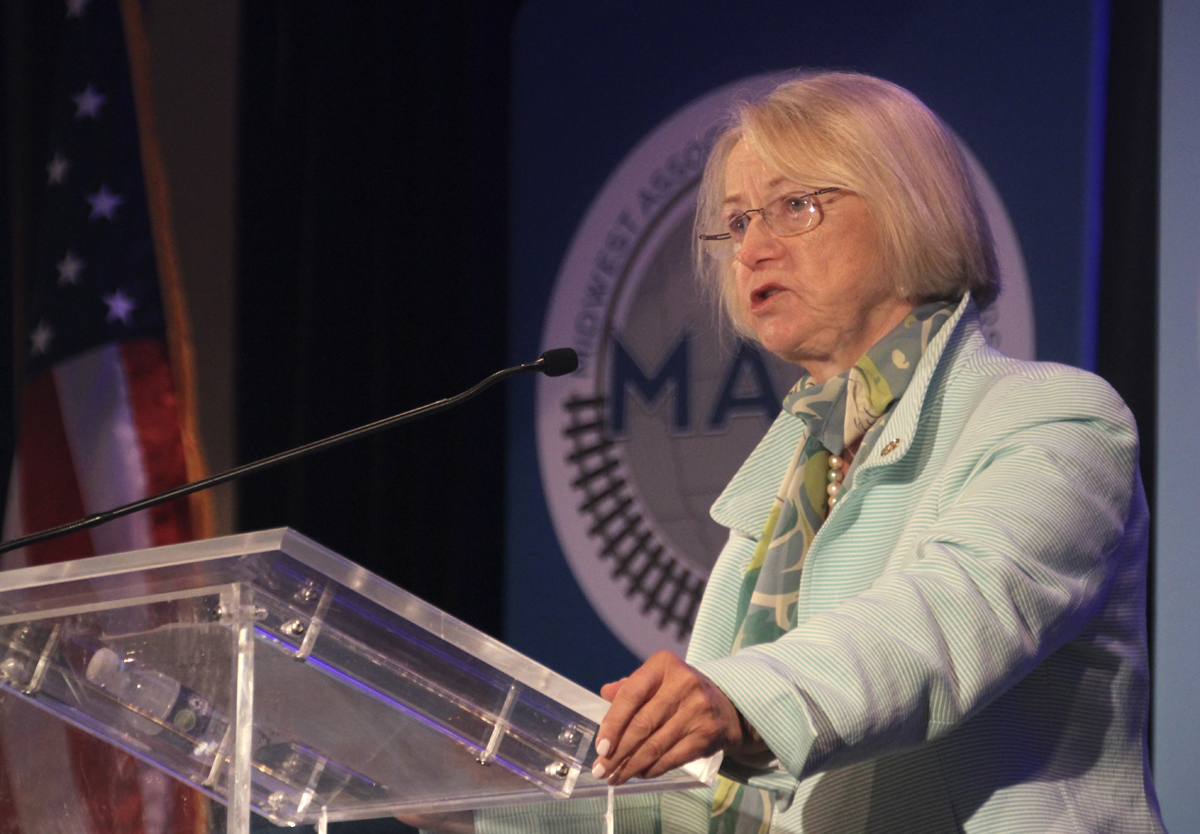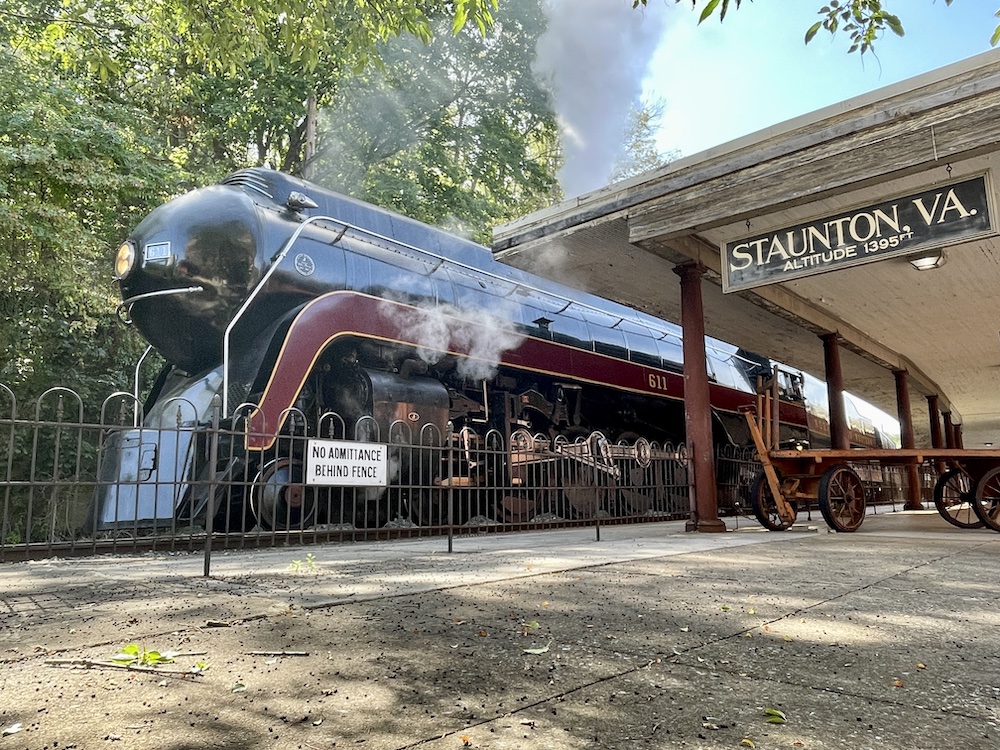LAMY, N.M. — The New Mexico Rail Passengers Coalition held a rally at the old depot in Lamy, N.M. to Save the Southwest Chief. Fifty people gathered in the park, the former location of El Ortiz Hotel, to hear elected officials and their representatives speak their support, on Oct. 18, for the continued operation of Amtrak’s Southwest Chief that serves rural communities in New Mexico.
Opening the event, NMRPC President Adrian Gurule introduced New Mexico Secretary of State and U.S. Senate candidate, Maggie Toulouse Oliver. Oliver spoke of the importance of rail transportation and the influence of train travel in her life growing up. “We all understand the importance of maintaining what we currently have in rail transportation,” Oliver says. “It’s incredibly important to our rural communities. We need to provide low cost access to transportation to everyone in rural America.”
Caroline Buerkle, representing Governor Michelle Lujan Grisham, reinforced the support that Grisham spoke of during a spring 2019 Southwest Chief rally in Las Vegas, N.M. Buerkle also said that the governor supports better service from the New Mexico Rail Runner commuter train that runs between Santa Fe and Belen, N.M.
Other speakers included Santa Fe City Councilor Peter Ives, Sandoval (N.M.) County Treasurer Laura Montoya, and Patricia Dominguez from New Mexico Senator Martin Heinrich’s office. NMRPC Vice President Alex Ramos read a prepared statement from the Rail Passengers Association chef and transit advocate Madison Butler and RPA President Jim Matthews. “As the largest rail passenger advocacy in the United States we want to express our support for the supporters of rail advocacy and long distance networking.”















Edit function please, #4 was meant to be a concluding remark, not another assumption.
I too have read the studies that look expanded motorcoach operations as a way to increase rural mobility. In general as a former DOT engineer who has actually been fairly involved in the planning and construction of one of the last Interstate Highways I see three typical assumptions underlying these types of studies that do not pan out in the real world.
1. Actual cost recovery for Interstate Highway infrastructure and accident costs (the two are related) is abysmal but since we have politically defined the collection of daily (gas) taxes on the use locally paid for streets to be a “user fee” for highways between cities it has been swept under the rug. When one actually looks at the cost per person-mile for highway infrastructure against the average aheemm “user fee” per person-mile through the gas tax there is around a $0.10 per person mile gap. Sure it is baked into the nature of the Highway Trust Fund and as such is covered by leveraging off taxes on the use of locally paid for streets and the now ever popular congressional deemed pension smoothing offset, but an honest analysis has to consider incremental effects per person-mile as we are a government for the people’s good.
A motorcoach using a highway really can’t be evaluated as a vehicle for the sake of figuring out if the whole system works but instead the infrastructure should be evaluated by person-mile in the denominator. Why, well if you don’t then you get to point #2 below, secondary effects on the highway infrastructure, through conversion to congesting private automobile travel in the urban areas.
2. Studies of proposed motorcoach assumption of intercity rail routes typically take ridership levels as static as though they are only determined by the origin and destination characteristics of the stops, but the reality is that much of the ridership will not convert over as typically seating personal space on a motorcoach is about half that of a rail coach, reducing the utility-of-time to a rider to use the journey time for productive uses. In the real world this is seen in the decline in volume of Greyhound type multi-stop operations unless apparently they are operated as feeders to intercity rail.
3. A motorcoach making all the stops that the comparable intercity train is making is going to be slower as it must leave the highway and travel to the stop then return and of course it must pause for meal stops and ADA restroom stops. The only motorcoach operations that are faster are the large metro to large metro only operations, but these don’t do much for long term support of the somewhat larger, say 20,000+ population, “gateway” cities of the rural states.
4. Finally, when Amtrak studied inserting motorcoaches into the middle of the Southwest Chief route the net operational deficit projected when up not down even with some pretty rosy assumptions regarding the coach passenger loss ratio after two additional transfers. The additional net projected operating loss was more than enough to fund the rail infrastructure renewal…
Mr/Ms Galen Riley – name calling takes away valid points, as you are the one trying to silence anyone that does not agree with your mindset. This is what is wrong today, so many refuse to listen to someone. You may actually learn something with your mouth closed. Admiral Hyman Rickover stated this quite eloquently to Congress in the 1950’s. In the rural parts of the Midwest, a single train, running from point A to point B, rarely, if ever on time, is not a productive form of transportation. If you personally live in rural America, you may understand that. As a business person, you position your assets for the greater good and best returns. Amtrak is a business. They pulled out of Eastern Oregon, Idaho, and northern Utah many years ago. This area has a much higher population than the majority of the route of the SW Chief (till you get to California). Just my humble opinion, no need for additional name calling.
See RPA report on the significant return on investment for just one train daily to the states of CO and N.M. if more than one train daily, the financial return should only improve…
Galen,
The NEC has the population to need NEC rail and all the rail commuter services in its areas which is why they have it. As for the bus service advantage, I’m only summarizing what several studies by various university transportation research groups (excluding Alaska & Hawaii) which all came to the same conclusion. Namely, its a far better use of government funds to support bus service with multiple trips per day in rural areas that can also offer more routes vs. putting all or most of it towards a single rail trip in each direction per day on a fixed route. These bus services can also be tied into larger airports as well as Amtrak stations in metropolitan areas. Neither of the studies said anything about eliminating Amtrak LD routes, but their results basically are saying that LD trains weren’t much of a factor when it came to solving rural transportation needs. Any politician who claims having one train a day through their state is the key to adequately serving the rural community isn’t really addressing the problem.
Personally knowing some of the academics that were involved in this research, I can assure you they definitely are not “Right Wing Nut Jobs” or “Left Wing Nut Jobs”.
Fewer people comment on this sight anymore because like most comment sections its been taken over by Right Wing Nut Jobs who slam anyone who voices an opposing opinion instead of voicing their opinion and moving on. They use their bullying & condescending responses when they can’t counter the opinion because they see their opinion as the only one that counts and by no one responding it just reinforces their belief that they are right. As for the bus service substitute for rural areas served by passenger rail this would also be an excellent option for the NEC as there are already numerous options for the traveler in that region & eliminating the NEC would be a substantial savings to the taxpayers. As some opine people live in rural areas by choice therefore others should not have to subsidize their “bad” choices the same can be said of those living in the heavily populated NE.
Mr. Foster just clarify most of my post was addressed to Mr. Landey’s comment about no one commenting on this topic my only comment about the bus options was the latter part perhaps I should have made a separate post. My mistake.
You subsidize bus service to rural areas if they need low cost public transportation. Its a lot cheaper and you can have more than one trip a day in each direction. Its only limitation is the availability of roads and there are far more of them than railroads in the area. No building costs for stations, no food service costs, and no delays due to freight trains on single track.
“No one has commented yet” says the note on this web page. No one has commented yet on this hot-button topic that’s been up on the page for several prime-time evening hours when most commenters post.
So why is that? Here’s why. There’s nothing to say. Even I, a mega Santa Fe fan, have nothing to say on the topic.
None of us want the Southwest Chief gone, least of all me, with all my gonzo loving memories thereof. But neither can anyone come up with a cogent path forward. It’s like going into a voting booth on election day, favoring the candidate who is going to lose and hating the candidate who you know will win. So you just go through the motions, cast your vote, go home and draw the shades. It’s like being totally invested in a marriage that your spouse is walking away from. It’s like coming home to find your house has burned down. What is there to say? Do you have the words to un-burn your house?
It’s like your 92-year-old father is sinking. He isn’t going to get better. You don’t want him to continue to suffer but you don’t want him to die. What is there to say? Nothing. You pace the hospital corridor while it all winds down. Nothing you can say or think or do makes any sense one way or the other. Then the doctor comes up to you and says, we can keep him alive on life support. Analogous to the Colorado and New Mexico senators keeping the Chief alive on life support when Amtrak doesn’t want the Chief any more and BNSF doesn’t want the tracks any more.
What is there to say abut the Southwest Chief? Nothing. There’s nothing to say. As with your dying father, there are the awesome memories. But that’s all there is.